This post may contain affiliate links. See my disclosure policy.
Learn How to Cook Pumpkin with this simple step-by-step guide – it’s easy! Simply cut, scoop, slather, and bake. Discover everything you need to know about sugar pumpkins from buying, different cooking methods, and uses.
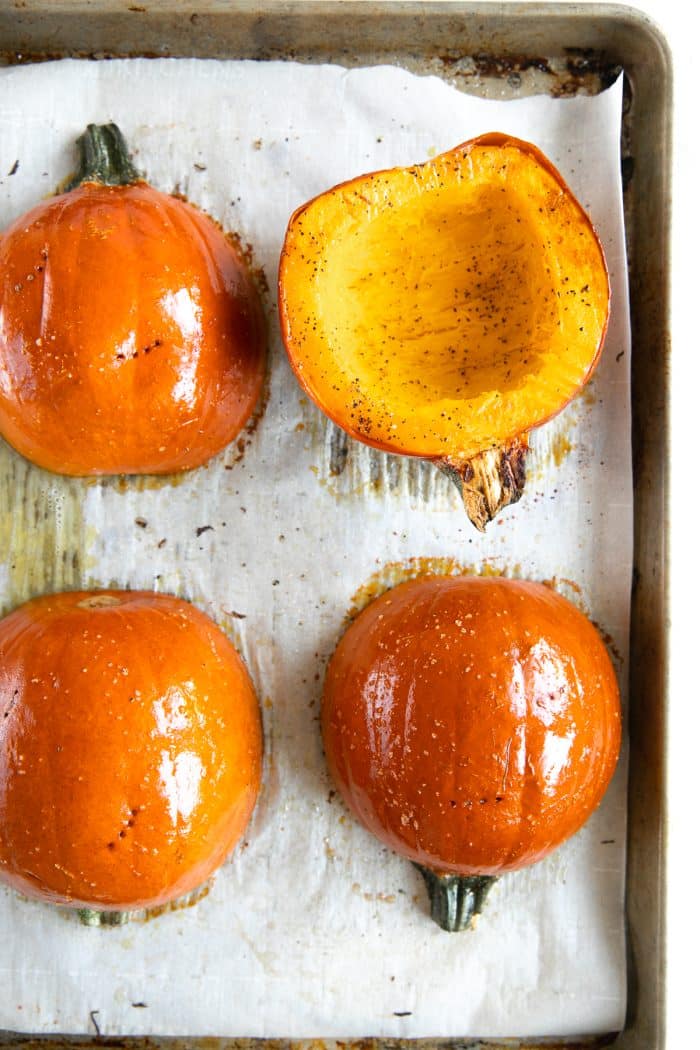
What are Sugar Pumpkins?
Also called pie pumpkins, sugar pumpkins are generally (though not always) much smaller than the big pumpkins you’ll find at the pumpkin patch used for carving jack-o’-lanterns.
These big pumpkins may look like the most logical choice, but they’re actually the worst for cooking and baking. Unlike sugar pumpkins, these larger carving pumpkins tend to be bland, watery, and stringy, resulting in less than ideal results once cooked.
Sugar pumpkins are cultivated specifically for cooking. They are sweet and flavorful with smooth flesh.
They come in several varieties and don’t all look alike. Some are round, some are small, some are large and fat, some oblong, and some orange, beige, or even white.
Common varieties include,
- Cinderella pumpkins
- Lumina Pumpkins
- Autumn Gold
Can you bake and eat the monster size carving pumpkins? Well, yes. However, if you can’t find the sugar pumpkins, I recommend opting for a different, sweeter squash – like roasted butternut squash or delicata squash.
How to Pick, Cut, and Prepare a Pumpkin for Cooking
When shopping for pumpkins at the grocery store that you plan to eat, not carve, look for ones that are labeled “sugar pumpkins” or “pie pumpkins”. Depending on the variety of sugar pumpkin, look for pumpkins that are between 4-8 pounds.
What should they look like? Some of the best-tasting cooking pumpkins are the funniest looking. As long as there are no soft spots or visible bruises, it’s good to eat.
And remember, pumpkins have a long shelf-life (around 2 months) so buy a few extra and keep them ready for later in the season.
After you’ve picked your pumpkin, you’ll want to keep it stored in a cool, dry place until you’re ready to make some magic in the kitchen.
Start first by washing the outside of your pumpkins and drying thoroughly. To bake, roast, and steam, cut in half and scoop out the guts and seeds (save them and make roasted pumpkin seeds) Season or leave them plain and cook to your preference.
How to Cook Pumpkin
Now that we know how to prep these cute little pumpkins, let’s talk about cooking.
Just like all types of winter squash, sugar pumpkins can be baked, roasted, boiled, stewed, steamed, and pureed. You can even cook them in your Instant Pot.
For the best flavor, however, I recommend slathering the skin and flesh in a little oil and baking or roasting in the oven. Baking is done at a lower oven temperature for a slightly longer cook time, while roasting is done at a higher oven temperature for a shorter cooking time.
Today, we’re baking our sugar pumpkins.
- Preheat oven to 350 degrees F and line a rimmed baking sheet with parchment paper.
-
Use a pastry brush to coat the pumpkin halves with oil then sprinkle with salt and pepper, if using. Transfer to your prepared baking sheet, cut-side-down. Pierce the skin with a fork in 2-3 places on each half to allow for steam to escape.
-
Bake for approximately 45 minutes, or until the flesh is easily pierced with a fork.
-
Remove the baking sheet from the oven and allow to cool for 5 minutes before scooping out the flesh or peeling away the skin.
-
Use in your favorite recipes or puree in a high-speed blender or food processor for homemade pureed pumpkin.
If you want to boil or steam your pumpkins, keep in mind that the pumpkin flesh will absorb water as it cooks. The result will be a pumpkin that is less flavorful and more watery than a pumpkin that has been baked or roasted. If you plan to make pumpkin puree, you will probably find that you’ll need to drain your pumpkin puree through a fine-mesh sieve or cheesecloth.

Puréeing Cooked Pumpkin
To puree your cooked pumpkin you may use an immersion blender, high-speed blender, or food processor. All you’ll need to do is process the cooked pumpkin flesh until smooth.
If you’ve steamed or boiled your pumpkin or your pumpkin happened to be extra watery, you may need to strain your puree through a fine-mesh strainer or cheesecloth.
Once you’ve drained any excess water, the puree is ready to use in any recipe that calls for pumpkin puree or canned pumpkin.
How to Use Baked Pumpkin
Sometimes it feels like there are a million uses for soft, perfectly cooked fresh pumpkin. Here are a few ideas to get you started:
- Make homemade pumpkin puree
- Stuff with your favorite whole grain, dried cranberries, and other roasted veggies for a complete meal or satisfying side dish
- Try making pumpkin cookies including these pumpkin oatmeal chocolate chip cookies or these pumpkin spice cookies
- Blend together with some cooked onion, celery, and carrots to make a deliciously healthy pumpkin soup
- Make pumpkin bread, pumpkin muffins, or pumpkin fresh toast for a very autumn breakfast or brunch
- Add to your favorite stews, risotto, or even salads!
- You can even toss it in a blender to make a pumpkin smoothie just as delicious as even the best pumpkin pie!
More Pumpkin Recipes,
How to Roast Pumpkin Seeds – coming soon!
Persimmon Pumpkin Pudding Cake
Pumpkin Pie Yogurt Overnight Oats
If you try cooking your own pumpkins, please leave me a comment and let me know! I always love to hear your thoughts.

How to Cook Pumpkin: A Step-by-Step Guide
Ingredients
- 1 (8-inch) sugar pumpkin
- 1 tablespoon olive oil , or avocado oil
- pinch of salt and black pepper, optional
Instructions
- Preheat oven to 350 degrees F. Line a rimmed baking sheet or small roasting pan with parchment paper.
- Cut pumpkin in half lengthwise (from stem to tip) using a steady sharp knife. Use a sturdy spoon to scrape and scoop the seeds and stringy bits from the center of the pumpkin (save for roasting or discard).
- Brush the pumpkin flesh and skin with approximately one tablespoon oil then sprinkle with salt and pepper, if using. Transfer to your prepared baking sheet, cut-side-down. Pierce the skin with a fork in 2-3 places on each half to allow for steam to escape.
- Transfer the sheet pan to the oven. Bake for approximately 45 minutes, or until the flesh is easily pierced with a fork.
- Remove the baking sheet from the oven and allow to cool for 5 minutes before scooping out the flesh or peeling away the skin. Use in your favorite recipes or puree in a high-speed blender or food processor for homemade pumpkin puree.
Notes
- Sugar pumpkins sweeter than jack-o-lantern pumpkins.
- One (8-inch) pumpkin will yield approximately 3 cups of pumpkin puree.
- Raw, whole pumpkins can last for up to 2 months when stored in a cool, dry place. Once cooked, keep your cooked pumpkin refrigerated in a sealed container as it will last for as long as one week.
- Store pureed pumpkin in freezer bags and in the freezer for up to 2-3 months.
- Pumpkin is naturally vegan and gluten-free.
Nutrition
Nutrition information is automatically calculated, so should only be used as an approximation.
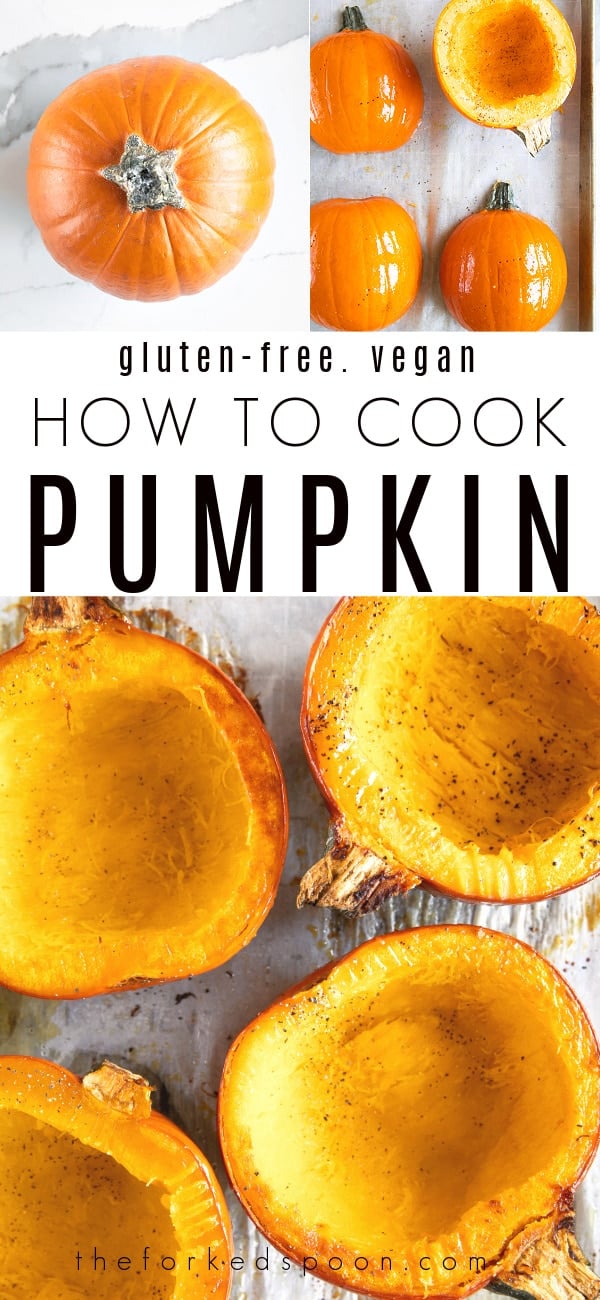

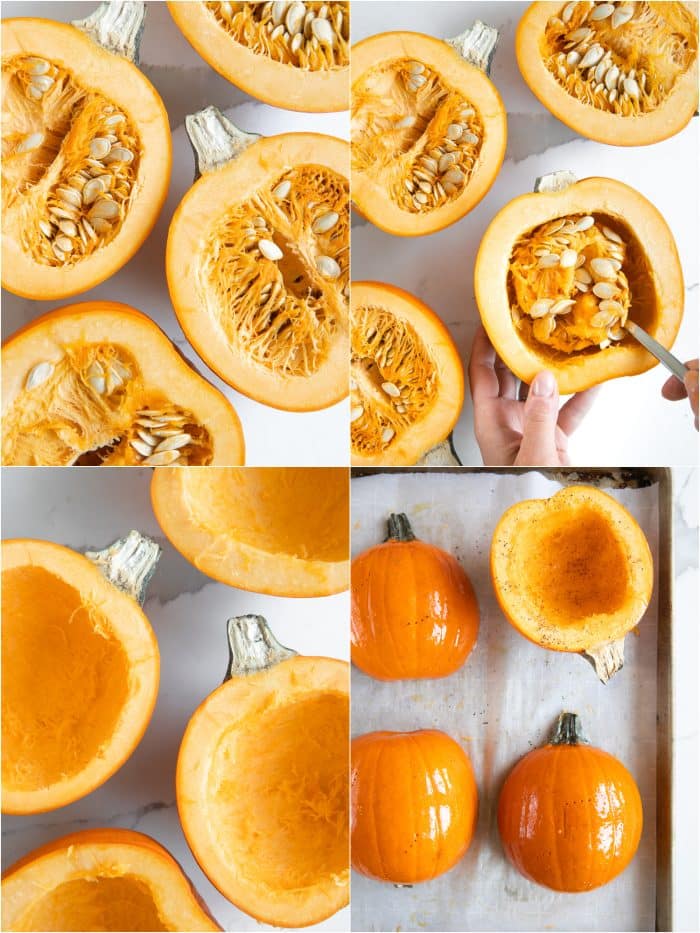

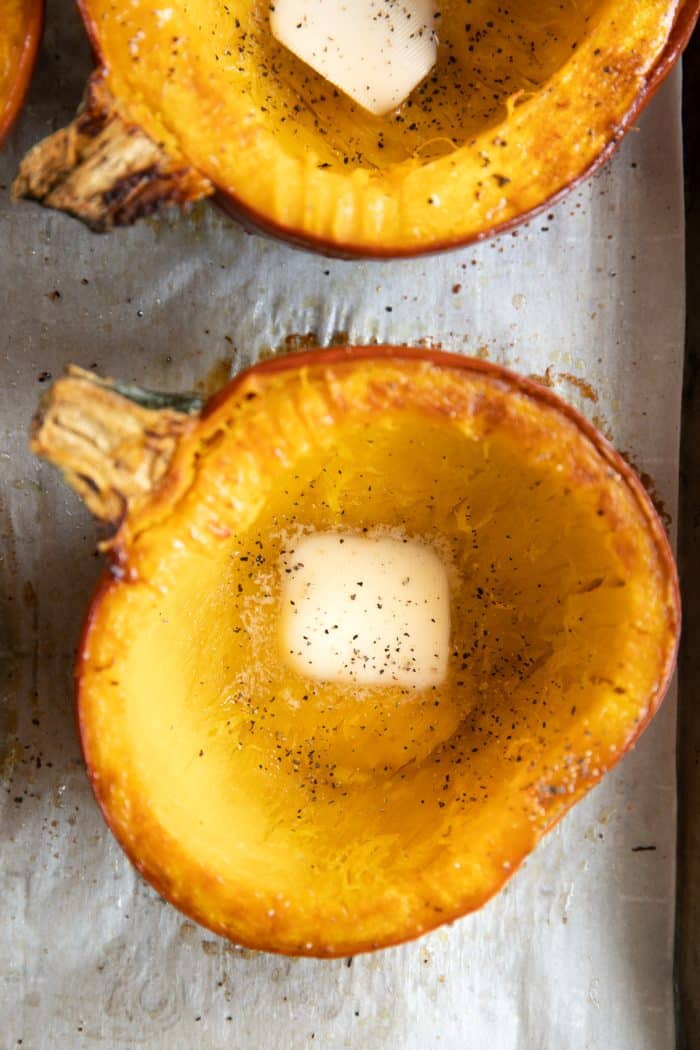

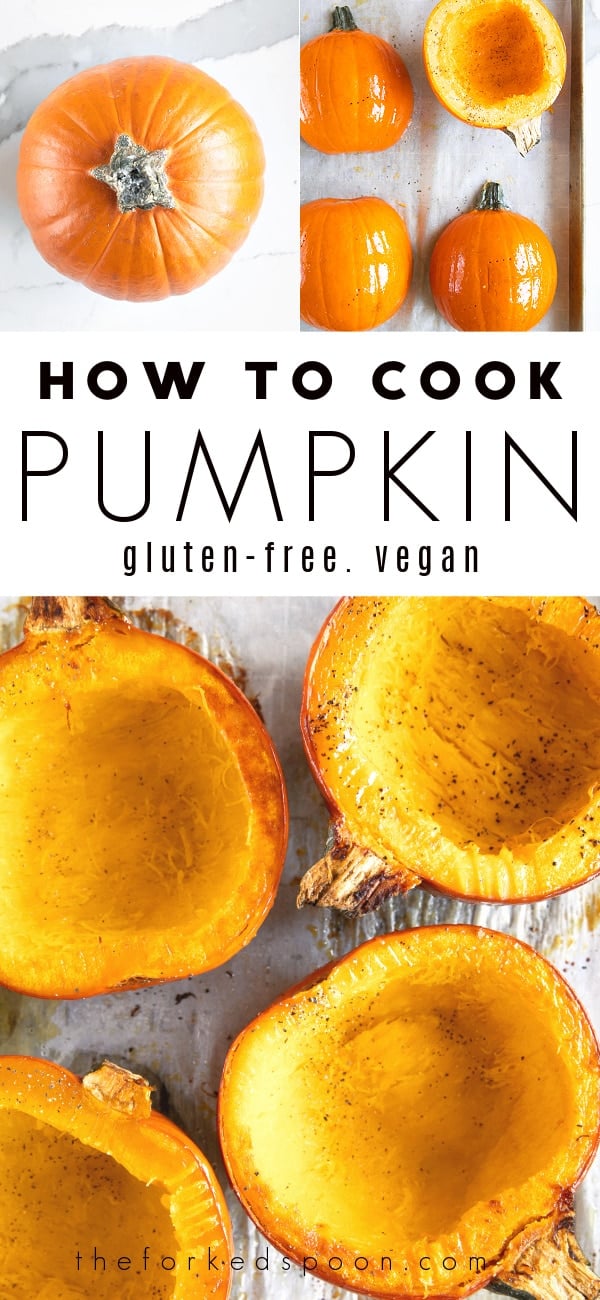
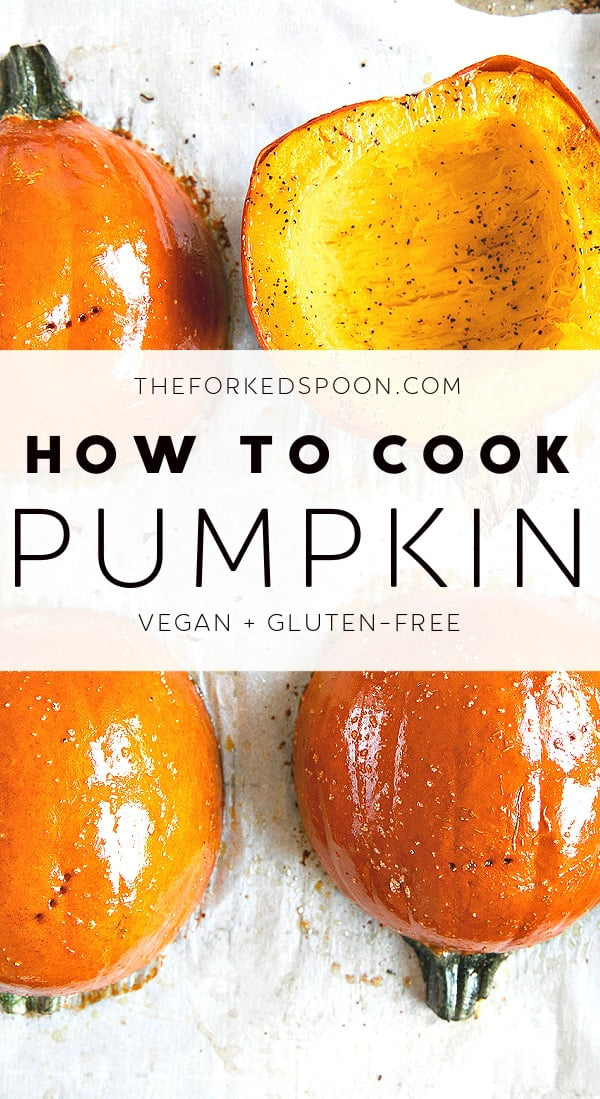














Can you peel it and boiled it for pumpkin puree
Here is my recipe for pumpkin puree 🙂
Will post after I’ve made it. Thanks
WOW, WOW, WOW!!!
Loving all you do…